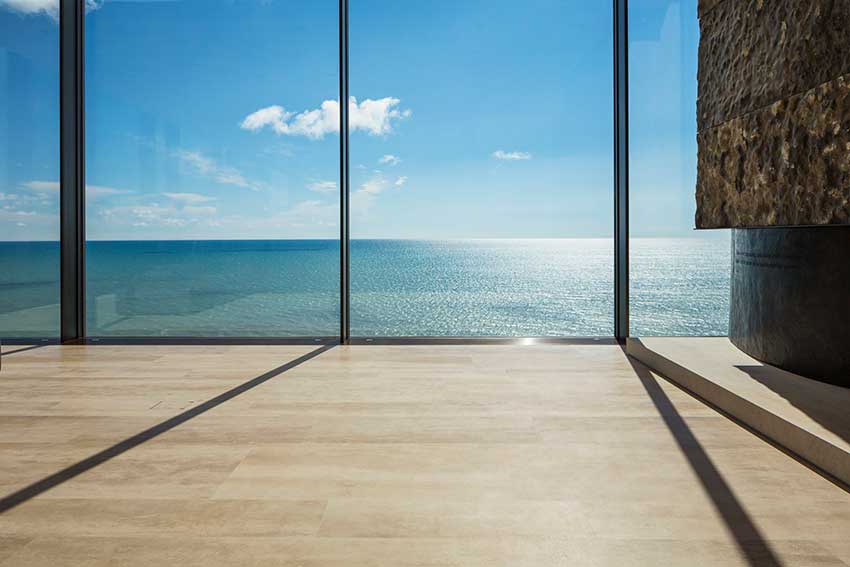All About Glass & Metals: Guide for Architects
PART 2: PRODUCTS
NEW IGU TECHNOLOGIES FOR CARBON REDUCTION AND NET-ZERO ENERGY
The last year has witnessed increasingly ambitious plans from organizations on the global, national, and state levels to meet carbon-neutral, net-zero goals in the next several decades. These plans look at “how we get to 2030, 2040, 2050 with some variant of carbon neutral, or net zero, or half reductions in carbon,” according to Stephen Selkowitz, principal, Stephen Selkowitz Consultants, affiliate, Lawrence Berkeley National Laboratory, speaking during the NGA Glass Conference: Long Beach.
To reduce carbon emissions and meet these benchmarks, the building sector must be addressed. “Buildings are about 50 percent of the problem [with emissions] when you look at embodied energy and carbon in construction,” Selkowitz says. “If we’re going to solve the big-picture global and national energy and carbon problems, buildings are going to have to be part of the solutions…And windows are a big part of this.”
Source: Based on a presentation at the NGA Glass Conference: Long Beach by Stephen Selkowitz, principal, Stephen Selkowitz Consultants, affiliate, Lawrence Berkeley National Laboratory.
Opportunities of Retrofit
Window performance improvements are often focused on new construction. However, Selkowitz says the existing building stock provides the largest opportunity for performance improvements on a wider scale.
“If we’re going to get to 2050 [emissions goals], we have to address existing buildings. We can’t build our way out of this with new construction. Something like 50 percent or more of buildings that will exist in 2050 are already here now, and most of them are single- or double-glazed. So, we need to be thinking about how we retrofit,” Selkowitz says.
Consider, if all existing commercial windows in the United States were replaced with highest-performance integrated facade systems, the market would go from a cost of $20 billion a year to a savings of $15 billion a year, says Selkowitz. “This is if you can magically change every building in the country, which isn’t going to happen,” he says. But it begins to demonstrate the potential savings that are possible when the industry focuses on existing buildings.
Highly Insulating Glazing Solutions
The glass industry offers numerous solutions to improve the performance of insulating glass in buildings. “Can we make the IGUs better thermally? We can play with coatings, with glazings, with the system, and to some degree with the whole building,” Selkowitz says.
Existing
Double glazing with gas fill represents about 89 percent of the market today. Triple and quad IGUs are in the market, but are often used only in the coldest climate zones. In the United States “in residential, triples have about 3 percent market share. I’m guessing it’s less in the commercial space,” Selkowitz says.
Emerging
Emerging IGU technologies include vacuum insulating glazing, VIG and thin triples, which consist of double glazing with a thin-glass interior lite. The technologies can be paired with additional improvements, as well. Low-emissivity coatings can be applied to VIG and to thin triples, with thin triples featuring up to two low-e coatings, and gas fill can be added to the thin triples.
“VIG has been around in a limited form for 20 years. There are some very good products out now, but there’s not a lot of market impact,” Selkowitz says. “There is a lot of new buzz in terms of hybrid [VIG], new R&D, new generation. That will hopefully make [the products] cheaper.”
Thin triples look to achieve the next-level performance of traditional triple IGUs, but deliver a product that is not as heavy, not as wide, and will fit in the existing pocket of a normal sash. “With the thin triple, you get about an R-8 center of glass,” says Selkowitz. “You’ve got a slightly larger glass package, you can put two pieces of thin triple and get R-14…This is great news. You can get an R-14 center of glass with a VIG, or with a quad glazing.”
Future
Looking ahead, Selkowitz identifies promising future IGU solutions, including two low-e vacuum hybrid units, which is an IGU that features VIG on one side of the unit. Insulating Aerogel is also promising.
“The [Department of Energy] has been putting a lot of research dollars into Aerogel in the last couple of years,” Selkowitz says. There are products out now that are highly insulating, but they are “granular diffusing,” which means they have a hazy white translucent appearance. “If you want clear Aerogel, you’ll have to wait a bit longer,” he says.

Photo courtesy of National Glass Association
Vacuum-insulating glazing was critical to the restoration of the 1955 Eero Saarinen-designed “Bird Cage” at the Milwaukee County War Memorial. The Bird Cage is a double cantilever staircase enclosed with a glass and steel curtain wall. The project features Pilkington Spacia VIG from NSG Group, which offers thermal performance improvements and a thin profile that allowed the glass to be incorporated into the original, restored curtain wall system. The restoration project architect was HGA Architects and Engineers, the preservation consultants, Preserve LLC, and the glazing consultant and contractor, Restoric LLC.

Image courtesy of AGNORA
PART 3: PEOPLE
DAYLIGHTING + VIEWS
In November 2021, plans for an 11-story, 1.68 million-square-foot dormitory building at the University of California Santa Barbara were revealed and quickly drew backlash from numerous leaders in the design community. The project, Munger Hall, designed by billionaire investor Charlie Munger, has been called “dangerous,” “a monstrosity,” “a social and psychological experiment with an unknown impact.”
The primary target of criticism is the designer’s bold choice to greatly limit access to natural daylighting and views for the building’s occupants. While the dorm is intended to house 4,500 students, 94 percent of them would not have access to windows in their compact single-occupancy bedrooms.









